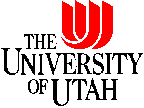
Math 1040-1: On-Line Course Syllabus
Spring Semester 1999

| Instructor | Davar Khoshnevisan |
|---|
| Office | JWB 106 |
|---|
| Telephone | (801) 581-3896 |
|---|
| Email | davar@math.utah.edu |
|---|
| Office Hours | Mon. 1-2 p.m. or by appointment
|
|---|
| WWW | http://www.math.utah.edu/~davar
|
|---|
| Texts | - Using and Understanding Mathematics
By Bennett and Briggs, Addison-Wesley Publishing, 1999
- Seeing Through Statistics
By Utts, Duxbury Press, 1996
|
|---|
| Lectures |
- TIME:
MW 11:50 a.m. - 12:40 p.m.
- PLACE:
EMCB 105
|
|---|

This is an introductory semester on quantitative reasoning. The main objective of this course
is to discuss and well understand quantitative/mathematical/logical reasoning, and to learn
some rudimentary statistical methods and ideas.
The course is divided in to main lectures and discussion sections. The theory and concepts will be
introduced in the lectures, while the discussion sections are devoted to the analysis of some case
studies, as well as problem solving. The students will regster for a discussion section; their
regiustration for the lectures is then automatic. These sections are lead by the following teaching
assistants (note that Section 1 is reserved for the lectures):
Attendence is mandatory for the lectures,
as well as the discussion sections. |

The course grade is based on several
pop
quizzes, two midterms, and a final examination. The maximum possible number of
points for each category are
| | Quiz | Midterm 1 |
Midterm 2 | Final |
|---|
| Points possible | 30 |
25 | 25 | 20 |
|---|
The students' course grade is then based on the following table:
| Scored Points | 0-49 | 50-60 | 61-75 | 76-90 | 91-100 |
|---|
| Course Grade | E | D |
C | B | A |
|---|
There can sometimes be variations within each of the above grade (e.g., A-, B+, etc.)
These are determined on an individual basis, according to the students' level of
activity and participation in the sections.
The grading is designed so that the student can continuously monitor his or
her performance throughout the course.
There are no make-ups for any of the quizzes and/or the exams.
The students should make all of their semesters' plans in advance. |
The only exception to this rule is a medical emergency, together
with written evidence of such an emergency.

Homework is assigned every week in lecture, and is also posted on the web.
The students are expected to have attempted (and solved most of) them by the end
of that week.
A good policy for studying for this course would be to attempt
the homeworks on time. Then, use the subsequent office hours
and discussion sections to understand any or all
of your unresolved problems. |
The midterms and the final will be taken in the lecture hall,
while the quizzes will be taken in the respective sections. |
The dates of the midterms and the final exams are given above.
All quizzes test the material covered since the previous quiz/exam.
Midterm 1 includes everything upto the material covered by the end of Feb. 8;
Midterm 2 does not include the material of Midterm 1; it does
includes everything upto the material covered by the end of March 8.
The final is comprehensive.
Homework assignments will not be collected. However, be aware
that the quizzes are given at unspecified times; you are strongly
encouraged to solve them in time, in order
to keep up with the development of the subject matter. |

| Mon. Jan. 11 | First day of classes |
| Mon. Jan. 18 | Martin Luther King/human rights day holiday |
| Fri. Jan. 22 | Withdrawal period I ends |
| Wed. Feb. 10 | Midterm #1 |
| Mon. Feb. 15 | Presidents' day holiday |
| Tue. Feb. 16 | Substitution day: lecture meets in the usual lecture hall from 11:50 a.m.
to 12:40 p.m. |
| Fri. Mar. 10 | Last day to withdraw |
| Wed. Mar. 10 | Midterm #2 |
| Mon. Mar. 15 | Spring break starts |
| Mon. Mar. 22 | Classes Resume |
| Thu. Apr. 29 | Classes end |
| Mon. May 3 | Final Exam; 10:00 a.m. - 12:00 p.m.;
same lecture hall |








